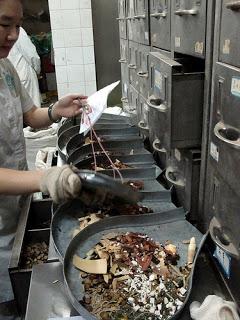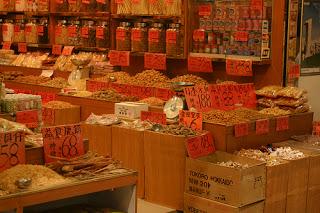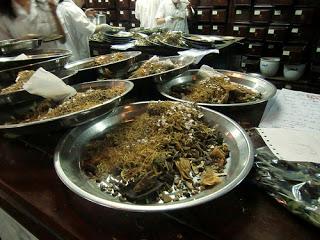
A TCM pharmacy.
Photo by Sam Steiner.
By Beth Green
Many times when you visit the doctor or pharmacy in China, you’re given a choice: traditional treatments made from herbs and mysterious ingredients, or Western-patented pharmaceuticals.
The first city I lived in in China had a specific hospital for Traditional Chinese Medicine (often just called TCM), and at the bus stop outside it there were always people wearing white bandages stained with brown poultices. Pharmacies usually featured both the comforting little rectangular boxes of pills that spelled out the ingredients in both Chinese and English and large dispensaries full of odd natural items that often looked like hedge-clippings or leftovers from a taxidermist’s shop. The air near the hospital and in the pharmacies had a distinctive smell—bitter and earthy.
I was always curious about experiencing TCM, but luckily I didn’t really need a doctor’s opinion in China until the second year I lived there. We’d just moved to a more rural city, with different weather and different food. My skin was not reacting well to the changes—and, distressingly, I’d picked up impetigo from some of the children I was teaching. After an Internet self-diagnosis of skin cancer (my self-diagnoses always include the worst possible interpretation of symptoms), I got the courage together to ask a co-worker to take me to the hospital across the road and see what a real doctor said.
At this hospital, and others I’ve been to since, when you come in to register you pick whether you want to see a nurse for a few yuan, a nurse with more experience for one yuan more, or a specialist for a whopping seven yuan (about a dollar at that time). Not one to skimp, I chose to visit the specialist dermatologist, who luckily was holding office hours.
The dermatologist had no waiting room; all of her patients grouped together in her small office on stools and listened avidly to her diagnosis and recommendation for the patients before them in line.
When it was my turn (me extremely conscious of the ten pairs of ears and eyes still in the room) she didn’t ask me any questions other than if my skin itched. I had my coworker explain my difficulties but the doctor simply nodded, had me stick out my tongue, and made a note.
“Will you take TCM?” she asked me in Chinese.
“It’s not cancer?” I replied.
She laughed, and so did the other patients behind me.

A TCM store in Hong Kong.
Photo by Brian Jeffery Beggerly.
Relieved of that, at least, I said, “sure, why not?” and so began a six-week course of TCM. The doctor explained that I would see results less quickly than I would if we used Western medicine, but that hopefully I’d experience better skin and more energy after using the TCM.
The treatment was in part restrictive: I had to limit spicy food, oily food, milk products, sugar, and caffeine. I had to eat more green vegetables. So far so good.
It included a topical treatment, which involved combining a paste with the contents of a glass vial, stirring it, and then applying it daily with a delicate wooden stick. The glass vial was the most frustrating, because it didn’t have a lid: you had to break the tiny top off of it without shattering the rest of the vial and dropping glass shards in the paste, without dropping it on the floor and shattering it and getting glass shards all over the bathroom, without shattering it and cutting your fingers. It took a few times—and return visits to ask for more medicine—to get this right.
I was also told to up my vitamin intake, which I could thankfully do with nice, comforting, Western-looking tablets.
And, I had to drink four servings of a special brewed medicine every day.
Now, the prescription for this medicine was several pages long, because the doctor listed twenty-some ingredients.
I knew that the prescription was lengthy, but I didn’t realize what exactly was in store for me until my coworker and I went to the pharmacy counter to pick up the medicines: three plastic shopping bags full of powders, leaves, and twigs.
“Um, what do I do with this?” I asked my coworker.
“You cook it,” she said.
Um, yeah.

Medicines before they are cooked.
Photo by Bernhard Scheid.
I was to keep this refrigerated, I was told, and drink it hot every day under certain conditions that I forget now. To warm it up, it worked best if I put it in a bath of hot water for a few minutes, then snipped a corner off the bag and slurped it out in one foul-tasting go.
Or, sometimes I put it in a coffee cup and pretended to myself I was drinking really bad filtered coffee.
It was a fussy, bewildering way to find a cure, but the impetigo cleared right up, and soon my skin was behaving itself too. I went back to the doctor several more times, for more medicine, until finally she gave me the all-clear.
I have always wondered what was in the medicine she prescribed, but at the end of the day, I’m just happy it worked.
What experiences have you had at foreign hospitals?

